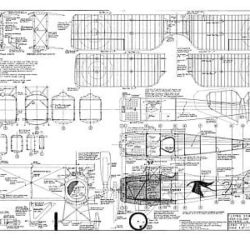SPAD S.VII History
In 1915, foreseeing that the rotary engine had nearly reached the limit of this development, Marc Birkigit, Swiss-born chief designer of Hispano-Suiza, evolved a new watercooled V-8 stationary engine promising an initial 150 hp. It was around an engine of this that Louis Bechereau produced in 1915 a tractor biplane known as the SPAD V, forerunner of a strain of fighters that was to become famous in the final years of the war.
The prototype SPAD VII flew for the first time in April 1916, powered by a 140 hp Hispano-Suiza engine. It was armed with a single synchronised Vickers gun in front of the pilot and, although, rather less manoeuvrable than the Nieuport, was much stronger and faster, with a first-rate turn of speed and an excellent climb to 12,000 ft (3,600 m). Production aircraft, with 150 hp Hispano 8Aa engines, began to be delivered early in September 1916, and by August 1917, 495 had been completed. They were supplanted by an improved model with the 175 hp Hispano 8Ac and slightly-increased wing span; about 6,000 of the latter version were built.
On the Western Front the SPAD VII served with numerous escadrilles de chasse, including the famous SPA.3 (Les Cigognes). From October 23 fifteen SPAD VIIs were supplied to Escadrilles 5 and 10 of the Belgian Aviation Militaire. Another nineteen, some fitted in the field with a wing-mounted Lewis gun in addition to the Vickers, were supplied to three Royal Flying Corps (RFC) squadrons in Mesopotamia.
The RFC bought some SPAD VIIs from France, but in addition to these another 200 machines were built in Britain. There were all delivered to the RFC; originally, 100 of them were earmarked for the Royal Naval Air Service (RNAS), but these were surrendered at the RFC’s urgent request and later replaced by Sopwith Triplanes.
Foreign sales included 214 SPAD VIIs to Italy, where they equipped five squadriglie including the celebrated 91a commanded by Francesco Baracca, 189 to USA, 15 to Belgium, and others went as far afield as Brazil, Greece, Peru, Portugal, Romania, Siam, Russia and Yugoslavia. Some of the Russian SPADs were flown armed with Le Prieur rockets. Among the first pilots to fly the SPAD VII in battle were the French aces René Fonck and Georges Guynemer, and the aeroplane quickly became a popular mount. After the war about a hundred SPAD VIIs, many of the rebuilds, were supplied to the Ecole Blériot at Buc, and many others were sold to air forces all over the world.









